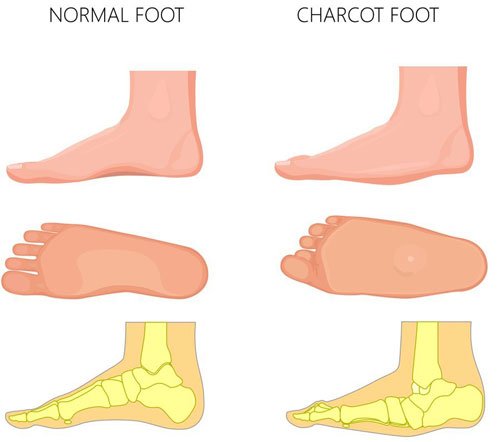What is Charcot Foot and How is it Treated?
Charcot foot is a condition that impacts the bones, joints and tissue in your foot and ankle. It can affect anyone with peripheral neuropathy, but people who also have diabetes are especially at risk. Left untreated, Charcot foot can lead to a permanent foot deformity. That’s why it’s critical to prevent this condition, or catch it in early stages, to prevent lasting damage or even amputation.
Understanding Charcot Foot
Charcot foot develop once you’ve lost sensation in your feet because of neuropathy. At some point, this condition weakens your bones; they may then break, causing your foot and ankle joints to dislocate. We don’t know exactly why people develop this condition, but it often sets in after an undiagnosed foot or ankle injury, like a sprain. Many diabetics who have an organ transplant also develop Charcot foot, since anti-rejection drugs can weaken the bones.
Signs and Symptoms
At first, Charcot foot leaves your foot red, extremely swollen and warm to the touch. Other symptoms depend on the location of your bone damage. In your midfoot, this condition causes your arch to collapse, so there’s rounding at the bottom of your foot. In other locations, Charcot foot can destabilize your ankle or make your toes curve unnaturally.
Early on, it may be difficult to diagnose Charcot foot, especially since your X-rays may initially come back as normal. That’s why you need to maintain regular diabetic foot exams if you have neuropathy. Westfield podiatrist Dr. David Sullivan can notice the early signs of this condition and begin treatment before damage becomes permanent.
Treating Charcot Foot in Westfield, IN
Once you’re diagnosed, we’ll treat Charcot foot by taking pressure off your feet, strengthening your weakened bones and taking measures to prevent new bone breaks.
First, we’ll off-load your foot, by taking pressure away using a cast or walking boot. Depending on the severity of your condition, you may knee a wheelchair or crutches during this treatment phase. You’ll need to keep off-loading until your foot is no longer warm, red or swollen.
Once your initial symptoms resolve, you’ll probably need to wear prescription shoes, designed to keep pressure off your feet. We may also change or monitor your physical activity levels to keep you safe from future problems.
If your foot was already deformed, you may need surgery. But with or without surgery, you will need to take long term precautions to manage your condition. Because with Charcot foot, you have an increased risk for future deformities, as well as for ulcers, which also increases your risk for amputation.
Concerned about your diabetic foot health and hoping to prevent complications like Charcot foot? We’re here to help. Schedule your comprehensive foot exam today. Because early detection is the best way to protect your diabetic feet and prevent any future complications.


